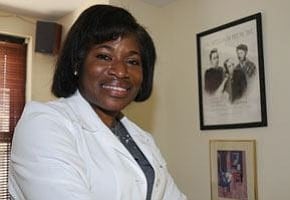We can avoid some heart disease risks
Cardiovascular disease is an epidemic in the African-American community—as are the multiple risk factors that can pave the road toward developing heart problems. Black Health Matters spoke with Donna Mendes, M.D., a vascular surgeon at St. Luke’s and Roosevelt Hospital in New York City, to shed a little more light on why heart disease is at epidemic proportions in our community and what can be done to remedy the situation without having to go under the knife.
BHM: What does a peripheral vascular surgeon do? And why did you choose this specialty?
What I often do in my work are surgeries to correct blocked arteries in order to get blood flowing back through the arteries and legs with the ultimate goal of preventing things like amputation. Additional surgeries that I do also help prevent strokes and treat aneurysms. When patients experience pain while walking, or let’s say, have a slowly healing ulcer in the leg, it can be due to peripheral arterial disease (PAD). With PAD you try to walk, but can’t because the main artery going down the leg has a blockage in it; the calf muscle needs oxygenated blood quite similar to a cut flower that needs to be put in water. Every organ in the body requires oxygenated blood. Picture the main blood tube in the body as an inverted “Y,” with the straight arm of the “Y” coming down the abdomen, and at the belly button it divides into two with a large vessel going into each side. I perform procedures on all of those vessels to augment flow through them.
I always wanted to be a surgeon. Initially I wanted to go into plastic surgery, but when you do rotations you become more involved in what with what the surgery results in, and I liked the excitement of working with blood. I hate to say it like that (laughs). But it really is exciting when everyone’s pulling together to make sure the patient pulls through and that you’ve helped them become free from pain.
BHM: Explain what the surgical procedure is like.
I perform procedures so that increased flow gets through or around a diseased vessel. Our approach is to be minimally invasive if possible. After we know exactly where the damage is, we take a thin guide wire, thread it through the narrow artery and pass a deflated balloon over the guide wire. Then we inflate the balloon where the blockage is to make sure it is open, rather than blocked. If that is not possible, then a bypass, which can be a vein or a graft, is sewn into the artery above and below the blockage.
BHM: What risk factors have played the most extensive role in leading to the high rates of surgical intervention among minority populations?
Diabetes, high blood pressure, high cholesterol, cigarette smoking and being African American are all significant reasons. If glucose levels or blood pressure are out of control, or there’s abnormal cholesterol levels, the arteries develop calcium in their walls. Eventually, the development of all that plaque causes the loop to become narrow or blocked.
BHM: How many of the cases that you’ve come across throughout your career could’ve been prevented through better health awareness or lifestyle choices?
A significant number. There are certainly things that we can’t prevent, like hypertension or diabetes. You can’t just say, ‘Oh, I’m not going to be a diabetic anymore,’ but there are also things you can control, like, cigarette smoking. People need to be more aware of what they can do to decrease salt intake, be more active and stop smoking! Male smokers, especially those older than age 65, are at a much higher risk of aneurysm.
BHM: We all know obesity and cardiovascular problems are linked and that both are epidemics, which disproportionately affect the African-American community. Why do you think this is so? What needs to change so people don’t end up on your operating table?
It all boils down to: “You are what you eat and you are what you do.” And if you’re eating more than you’re doing, that’s a great place to start to make a change. Just watching your weight and opting for fresh foods versus processed kinds can regulate lipids and blood pressure. Walking is a great thing. Your body responds to its needs when it’s moving. The more you walk, the more the body starts to develop extra blood vessels to go around blocked arteries and can sometimes even reverse things before they need to be fixed through surgery. Make certain you’re as informed as you can be, keep on top of your prescriptions if you take any and monitor whatever risk factors you have, glucose or pressure levels for example.






